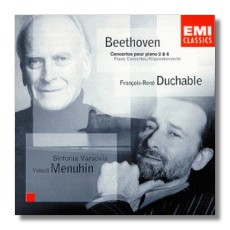
The Internet's Premier Classical Music Source
Related Links
- Beethoven Reviews
- Latest Reviews
- More Reviews
-
By Composer
-
Collections
DVD & Blu-ray
Books
Concert Reviews
Articles/Interviews
Software
Audio
Search Amazon
Recommended Links
Site News
 CD Review
CD Review
Ludwig van Beethoven

Piano Concertos
- Concerto for Piano #2, Op. 19 (1795)
- Concerto for Piano (#6) in D Major, Op. 61 (1807)
François-Rene Duchable, piano
Sinfonia Varsovia/Yehudi Menuhin
EMI 56875
Yes, your eyes – and ears – do not deceive you. Beethoven did write one more piano concerto beyond the canonical five. Never heard it before? You've probably know it as its earlier incarnation: the great D-major Violin Concerto. Urged by publisher Muzio Clementi to transcribe the Violin Concerto for piano, Beethoven set to work on the piece, believing Clementi's assertion that it would vastly increase sales of the original score (which had been getting bad reviews for "lack of coherence"). The Violin Concerto's immortality didn't quite occur that way. Instead, the public took to it independently of the transcription. But what we have is an intriguing oddity in the history of music, comparable to Bach's keyboard transcriptions for guitar.
In adapting the work, Beethoven does not simply transcribe it note for note. He provides it with a supporting left-hand part, most noticeable in the Larghetto that Duchable plays so sensitively, yet sometimes as a continuo-like device and other times as an accompanying ostinato. Most notably, he adds four cadenzas, two small and two large ones. The famous cadenza that appears in the opening Allegro takes some getting use to. But once you begin to accept it, the addition of timpani for dialog seems not only appropriate but absolutely tintinnabulous. The final cadenza in the Rondo is charged with virtuosic demands on the soloist, which Duchable fills with jolting rapidity.
Yehudi Menuhin (Of all people! A violinist!) conducts the Sinfonia Varsovia with a sure baton through these challenging innovations by the master.
Both performers are more workmanlike in the flip-side Piano Concerto #2, which holds no surprises. It is a charming rendition nonetheless, slightly weighted more toward a classical performance style than a romantic one. It is well worth hearing Duchable working his skills with an excellent sonic balance.
But that's not why you'll buy this CD, is it? You will buy it to hear the warhorse gallop over the hills and valleys once again, this time on a different route with its mane blazing another color, but with a stride none less sure.
Copyright © 2000, Peter Bates


















